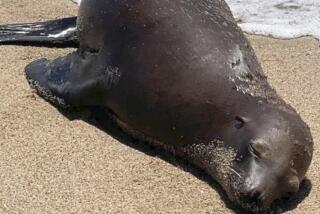Mountain lion attacks are rare. But people should be on guard
A family hike Monday afternoon turned into a terror-filled fight to save a 3-year-old boy from a mountain lion after the predator snatched the child by the neck and began to haul him away, authorities said.
Attacks like the one in Orange County are rare, officials say, but humans and the wild cats share hillside and mountain terrain, and experts say the incident is a reminder for people to use caution when in mountain lion country.
What happened?
A 3-year-old boy was walking through Whiting Ranch Wilderness Park on Monday with his family when a mountain lion pounced on the child, officials said.
The lion seized the boy by the neck, creating puncture wounds, and started to drag him away, said Capt. Patrick Foy of the California Fish and Wildlife law enforcement division. The child suffered abrasions from being dragged along the ground.
The boy’s father threw a backpack at the big cat, which released the child and snatched the bag instead. Someone later took a picture of the cat with the backpack up a tree.
The child suffered neck injuries and abrasions, but his injuries are not thought to be life-threatening.
What happened to the mountain lion?
A sheriff’s deputy killed a mountain lion near where the child was attacked a short time later.
Authorities are confident they killed the same cat that attacked the child because it was in a tree along with the backpack the boy’s father had thrown at it.
Wasn’t there another attack at the park some time ago?
In January 2004, a mountain lion killed avid biker Mark Reynolds, 35, of Foothill Ranch. He apparently was crouched over, fixing his bike, when the animal attacked. Experts at the time said a big cat will sometimes interpret a crouching animal as a sign of weakness. Reynolds was probably in greater danger because he was alone.
The mountain lion partially buried Reynolds’ body, another common behavior with prey. The same cat then attacked another biker, possibly because she unknowingly came near Reynolds’ body. A friend and other bikers pried the woman away from the cat, which later was killed.
How can I stay safe while in mountain lion territory?
The California Department of Fish and Wildlife recommends the following tips:
- Avoid hiking or jogging when mountain lions are most active: dawn, dusk and at night.
- Do not hike, bike or jog alone. Stay alert on trails.
- Keep a close watch on small children.
- Off-leash dogs on trails are at an increased risk of becoming prey for a mountain lion.
- Never approach a mountain lion. Give them an escape route.
- Do not run. Stay calm. Running may trigger chase, catch and kill responses. Do not turn your back. Face the animal, make noise and try to look bigger by waving your arms or opening your jacket if wearing one; throw rocks or other objects. Pick up small children.
- Do not crouch down or bend over. Squatting puts you in a vulnerable position of appearing much like a four-legged prey animal.
- Be vocal; however, speak calmly and do not use high-pitched tones or screams.
- Teach others how to behave during an encounter. Anyone who runs may initiate an attack.
- Carry and know how to use bear spray to deter a mountain lion. Bear spray has been shown to be successful in emergency situations with mountain lions. Have the spray readily accessible. Carry it in a holster or attached to a bike. Make sure you know how to properly use bear spray; people have been known to spray their own faces when attempting to use it.
- If a lion attacks, fight back. Research suggests that many potential victims have fought back successfully with rocks, sticks, garden tools, even an ink pen or their bare hands. Try to stay on your feet. If knocked down, try to protect your head and neck.
- If a mountain lion attacks a person, immediately call 911.
More to Read
Sign up for Essential California
The most important California stories and recommendations in your inbox every morning.
You may occasionally receive promotional content from the Los Angeles Times.












